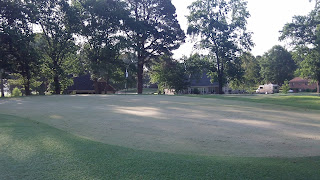The old flag situation also created some headaches from a maintenance standpoint. Because of a number of different people doing course set-up, it was hard to keep track of the previous pin location. This meant that in any given week, the pin might be repeatedly move back to the same general locations. That is not good for the health of the greens. The wear caused by the golfers needs to be evenly distributed over the entire surface to help prevent compaction and turf wear. Also, most people want a variety of different pin location to make it fun and challenging.
Last year, as the new superintendent at Back Acres, I noticed these issues. I decided that a new pin location system could easily be developed and implemented. Because of my work experience at high end clubs, I knew that a pin sheet marked with different pin locations would work best. The greens are mostly odd shapes, so they would have to be represented on the pin sheet true to shape for it to work best. I tried a few methods to get an accurate representation of the shapes, but found that hand drawing them would be the easiest. I used Google Earth's overhead views to help get the shape and positioning of the greens. After all the greens were drawn, I divided each one into six sections. These sections were label 1-6 and the locations were evenly distributed so each number would have 6 front, middle, and back locations.
Along with replacing all the old flags with new white flags, we started using the new pin sheets. The sheets are printed front and back on a laminated sheet of paper and are available to golfers when they check in at the pro shop. The pin location for the day is also passed along to the golfer so they know which location to refer to on the sheet. So far it has been working great and, as an added bonus, we can finish setting pins faster because there is no need to switch flags. I think over time the greens will benefit from less wear and players will have more fun.





